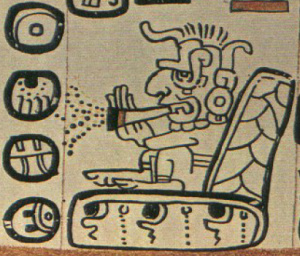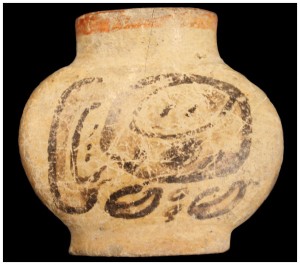 There is a great deal of evidence that the Maya used tobacco. Mayan hieroglyphics referring to tobacco have been translated. Deities, kings and shamans are often depicted smoking in Mayan art and iconography. The God L is depicted smoking a cigar on a wall relief in the Mayan city of Palenque, Mexico. A monkey deity smokes a cigarette on a vase from the late Classic period (200-800 A.D.). The Madrid Codex (pdf), one of the few Mayan historical records to survive the Christianizing zeal of the Spanish conquistadors, has multiple images of people smoking.
There is a great deal of evidence that the Maya used tobacco. Mayan hieroglyphics referring to tobacco have been translated. Deities, kings and shamans are often depicted smoking in Mayan art and iconography. The God L is depicted smoking a cigar on a wall relief in the Mayan city of Palenque, Mexico. A monkey deity smokes a cigarette on a vase from the late Classic period (200-800 A.D.). The Madrid Codex (pdf), one of the few Mayan historical records to survive the Christianizing zeal of the Spanish conquistadors, has multiple images of people smoking.
What we didn’t have, however, was physical evidence of the presence of tobacco in Mayan artifacts. Since we can’t know from a painting or a carving what the characters are smoking, finding the remains of tobacco fills in a major part of the historical puzzle. Using cutting edge chemical analysis, Dmitri Zagorevski, a scientist at Rensselaer Polytechnic Institute and Jennifer Loughmiller-Newman, an anthropologist from the University at Albany, have done just that.
They tested the residue inside 50 Mayan vessels from the Kislak Collection at the Library of Congress using gas chromatography mass spectrometry (GCMS) and liquid chromatography mass spectrometry (LCMS), two highly precise but non-invasive methods to detect the presence of the specific substances even from minute samples. Most of the containers showed no trace of nicotine, either because there was never any in there or because it was removed by water or bacteria, contaminated in antiquity or after excavation, or simply because the vessel was reused enough over the years to destroy any residue.
 Only one of the vessels, a small 2.5-inch-by-2.5-inch clay flask made around 700 A.D. in Southern Campeche, Mexico, passed the nicotine test with flying colors.
Only one of the vessels, a small 2.5-inch-by-2.5-inch clay flask made around 700 A.D. in Southern Campeche, Mexico, passed the nicotine test with flying colors.
Zagorevski and Loughmiller-Newman’s analysis of the vessel found nicotine, an important component of tobacco in residues scraped from the container. Both techniques confirmed the presence of nicotine. In addition, three oxidation products of nicotine were also discovered. Nicotine oxidation occurs naturally as the nicotine in tobacco is exposed to air and bacteria. None of the nicotine byproducts associated with the smoking of tobacco were found in the vessel, indicating that the vessel housed unsmoked tobacco leaves (possibly powered [sic] tobacco) and was not used as an ash tray. No other evidence of nicotine has been found, at this time, in any of the other vessels in the collection.
The flask is decorated with a hieroglyphic text that reads “y-otoot ‘u-may,” meaning “the home of his/her/its tobacco” which you’d think would make it a shoe-in for the presence of nicotine, but this is actually only the second time ever that the contents of Mayan vessel have been found to match its label. (The first was a cacao vessel.)
Tobacco had many uses in Mayan society. The powdered tobacco held in this flask could have been chewed or inhaled like snuff. It could also be used in household applications, as a snake repellent and to kill botfly larvae.
I feel an overwhelming urge to use that top image for something. I don’t know what yet though.
I’m sure it will be for evil. :skull:
Very informative and not something I’ve thought about before. I didn’t know people used tobacco as a snake repellent!
Is it okay if I add your blog to the blogroll on my own site? If you would like to check it out first, it’s http://www.thingsyouneverthoughtof.blogspot.com
Thanks again.
It’s very sweet of you to ask. I’d be honored. :thanks:
Mayas are a very smart civilization!
I’ve thought about before. I didn’t know people used tobacco as a snake repellent!
gtg
Thanks for sharing the Madrid Codex. We are preparing an article about the history of cigars and it was definitely very helpful.